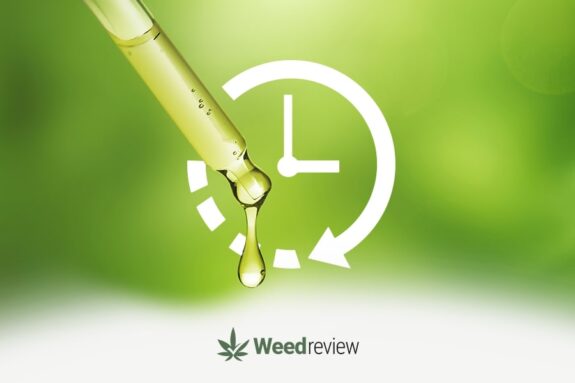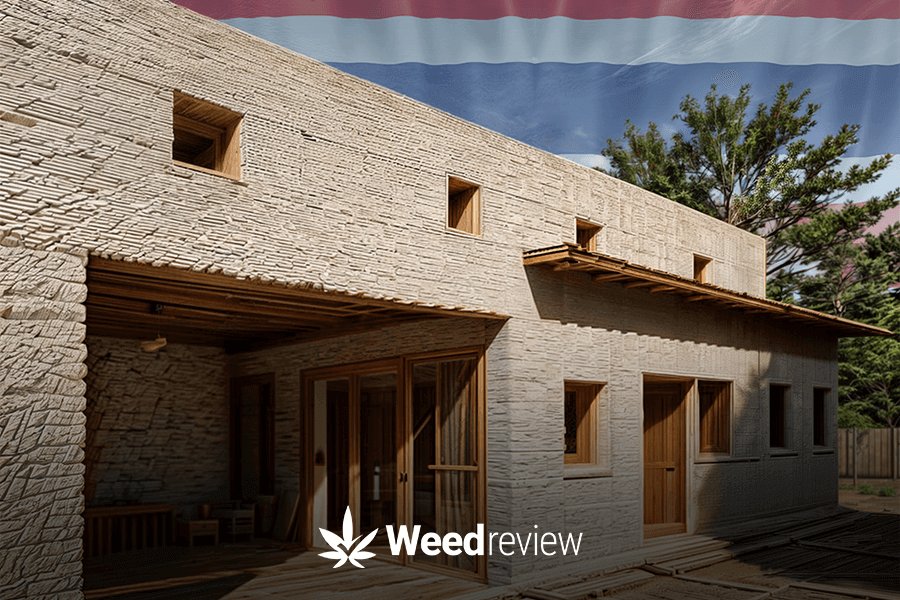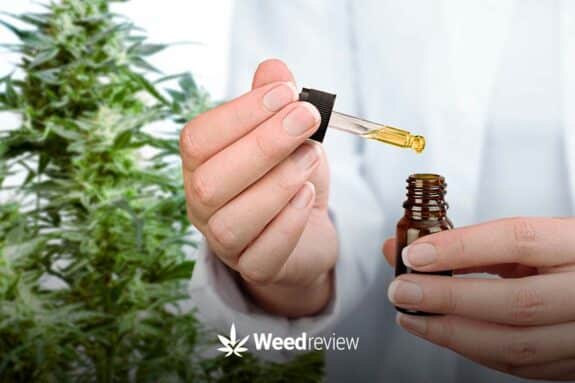
Hempcrete in Thailand: Material Qualities, Costs, and Where to Buy

Table of Contents
Welcome to the world of hempcrete, a sustainable building material capturing the attention of architects, builders, and environmentalists worldwide.
This article looks into what hempcrete is, its historical roots, and why it is coming back in modern construction. We’ll explore its composition, how it’s made, the various forms it can take, and where to buy it in Thailand.
Beyond its basic definition, we’ll examine the key properties that make hempcrete a standout choice for eco-friendly construction, including its environmental benefits, physical attributes, and thermal performance.
What is hempcrete?
Hempcrete is a bio-composite material made from a mixture of hemp shivs – the woody core of the hemp plant – a lime-based binder, and water. This unique combination creates a lightweight, insulating material for walls, roofing, and flooring.
Hempcrete’s role is to enhance the building’s environmental credentials and occupant comfort, rather than to serve as the primary load-bearing element. It is used as an insulating infill within a frame.
This means that while hempcrete contributes greatly to the thermal performance, fire resistance, and overall sustainability of a building, the structural integrity of the construction must be provided by other materials – like wood or steel.
Hempcrete is carbon-negative, effectively sequestering more CO2 during its growth and production than it emits over its life cycle. This ability to sequester carbon, actively capturing and storing atmospheric CO2, positions it as a crucial material in combating climate change.
How is hempcrete made: Composition & production
The primary components of hempcrete are:
- Hemp shivs: Sometimes called hemp hurd, this inner woody core of the hemp stalk provides bulk and insulation properties.
- Lime-based binder: Acts as a binder for the hemp shivs, offering durability and resistance to pests and mould.
- Water: Facilitates the chemical reactions needed to make the mixture solid.
The manufacturing process involves mixing hemp shivs with a lime-based binder and water in specific ratios. Hemp hurd has a high silica content which makes it easier to bind with lime.
This mixture is then cast into moulds to form blocks, and panels or applied directly as a wet mixture for on-site construction. The lime in the mixture reacts with the water to harden over time, encapsulating the hemp shivs and forming a solid, lightweight, and insulating material.
Hempcrete products
Hempcrete can be manufactured into various forms, including blocks, bricks, and panels, offering flexibility in its use for different construction needs. Its texture is typically lightweight and porous, contributing to its insulation properties.
Hempcrete in Thailand: A quick look at the market
With Thailand’s government actively amending legislation to encourage hemp cultivation and processing, the country’s hemp market is on the cusp of a major transformation.
The decision to deregulate parts of the cannabis and hemp plant has opened doors for entrepreneurs, farmers, and investors keen to explore the economic benefits of hemp. Here’s a glance at hemp’s market potential:
- The Thai domestic hemp market is expected to have a value of 15.6 billion THB by 2025. The global hemp market is expected to reach 18.6 billion USD by 2027.
- Organisations like the Thai Industrial Hemp Trade Association (TITHA) have also been created to promote hemp businesses.
It is worth noting that these figures focus on popular hemp items like supplements, oils, seeds, beauty products, and fibre. While hempcrete represents an exciting new avenue in sustainable building, it is not yet widely available in Thailand’s mainstream construction market.

The concept of building with hempcrete is still relatively new in the region, and the material’s use is mostly seen in niche, environmentally conscious projects. Only a handful of local players like Hemp Thai specialise in working with hempcrete.
From a research point of view, only a handful of universities, like the Rajamangala University of Technology Thanyaburi, have worked on it. Compared to medical cannabis research which has been more extensive, hempcrete still has ways to go in becoming mainstream like cannabis.
This scarcity means those interested in using hempcrete for construction projects might have to take a more hands-on approach by producing their material. This involves sourcing high-quality hemp hurd and mixing it with an appropriate lime binder, which requires some knowledge of material science and construction techniques.
Properties of hempcrete
We will now look at the properties that make hempcrete a sought-after material in the construction industry. From its ability to insulate, trap heat, and absorb noise, to being fire-retardant, there’s a lot that hempcrete can do.

How strong is hempcrete?
Hempcrete is not a strong material. It typically has a compressive strength in the range of 0.5 to 1 MPa (MegaPascals) – much lower than traditional concrete, whose strength stands around 20 to 40 MPa or more.
The relatively low compressive strength of hempcrete highlights its use as a non-structural, insulating material rather than a load-bearing one. It can provide sufficient strength for non-load-bearing walls, insulation, and acoustic barriers.
Is hempcrete a good insulating material?
Hempcrete has excellent insulation properties – largely due to its high porosity and low thermal conductivity. These traits mean hempcrete is great at trapping air and slowing heat transfer.
For a tropical country like Thailand, where weather conditions are optimum for growing hemp, hempcrete can greatly improve home comfort by keeping it cool during summers and warm during winters.
Let’s look at this in detail:
Hempcrete has a high R-value
The R-value measures how well a material can resist the flow of heat. Think of it as a blanket’s warmth; the higher the R-value, the better the material keeps heat in (or out). Hempcrete, with an R-value of 2.5 to 4.0 per inch, provides effective insulation.
If your walls are made of hempcrete, your home will do a better job of staying warm in cold weather and cool in hot weather. This means less dependence on heating and cooling systems, leading to lower energy bills and a more comfortable indoor environment.
Hempcrete is highly porous
Hempcrete’s ability to insulate is significantly boosted by its porosity, which is about 70 to 80%.
This porosity allows hempcrete to trap air in numerous tiny pockets within its structure. Since air is a poor conductor of heat, this trapped air greatly enhances hempcrete’s insulation capabilities.
This makes hempcrete an insulator against temperature changes and a regulator of indoor humidity, ensuring a comfortable and mould-free living space.
Is hempcrete fireproof?
Hempcrete is known for its excellent fire resistance, making it a safe and reliable material for construction purposes. While no material can be completely “fireproof,” hempcrete’s composition gives it an inherently fire-resistant quality. Here’s how:
- Natural fire resistance: Hempcrete’s mixture of hemp shivs and lime binder naturally resists combustion, slowing the spread of fire.
- Safety benefits: Its fire-resistant properties mean hempcrete walls can offer crucial extra evacuation time during a fire, helping to protect occupants.
- Testing and standards: Through fire safety tests, hempcrete has shown a strong ability to withstand high temperatures, contributing minimally to fire spread and smoke.
Is hempcrete soundproof?
Hempcrete provides excellent sound insulation properties thanks to its dense, fibrous structure, which naturally dampens sound.
The material’s acoustic absorption coefficients, which measure its ability to absorb sound rather than reflect it, are impressively high – around 0.5 to 0.85. This means hempcrete walls can effectively reduce noise transmission from outside to inside a building and vice versa.
This translates to a quieter living or working space, where external noises such as traffic or neighbourly sounds are significantly muted. Inside, it helps keep rooms more acoustically independent, enhancing privacy and reducing echo. Hempcrete’s acoustic properties make it an excellent choice for noisy buildings or spaces requiring sound privacy, like offices and residential buildings.
Pros & cons of hempcrete
Exploring the advantages and limitations of hempcrete offers valuable insights for anyone considering this sustainable building material.
On the plus side, hempcrete is celebrated for its carbon-negative impact. Its superior thermal and acoustic insulation properties enhance living comfort and yield substantial energy savings over time. The material’s inherent fire resistance and ability to regulate indoor humidity further promote a safe and healthy living environment.
| Pros of Hempcrete | Cons of Hempcrete |
|---|---|
| Carbon-negative material | Not load-bearing |
| Excellent thermal insulation | Requires a frame for structural support |
| Good acoustic insulation | Longer curing time than traditional materials |
| Fire-resistant | Higher initial cost than some conventional materials |
| Regulates indoor humidity | Limited availability in some regions |
| Resistant to mold and pests | Requires specialised knowledge for installation |
| Reduces energy bills | May not be suitable for all climates |
On the flip side, hempcrete does have some cons.
Notably, hempcrete is not a load-bearing material and requires a structural frame for support, which can introduce additional steps in the construction process. The longer curing time compared to traditional materials may extend project timelines, and the initial investment can be higher.
Furthermore, hempcrete’s suitability varies with climate conditions. Its performance may be compromised in extremely humid or very dry environments. High humidity can lead to prolonged moisture absorption, affecting thermal efficiency, while very dry climates might increase the risk of material cracking.
What are the different uses of hempcrete?

Hempcrete is a versatile building material that offers a wide range of applications in construction:
- Its primary use is in constructing walls, floors, and roofing systems, where it acts as an insulating infill within a structural frame.
- Hempcrete is also used as an insulation to create acoustic barriers.
- Its breathability and moisture regulation make it ideal for climate control in buildings, enhancing comfort and indoor air quality.
- Additionally, hempcrete is used in retrofitting historic buildings, offering a sustainable renovation solution that improves energy efficiency without compromising structural integrity.
How much does hempcrete cost?
Hempcrete pricing is either per square meter (or square feet) or by the pallet, which holds multiple blocks. Prices range from $30 to $100 per square meter depending on the block thickness. A pallet’s cost can vary between $300 and $1,000, depending on the quantity and size of the blocks.
The cost of hempcrete can vary widely depending on several factors, including location, availability of materials, and the scale of the project.
On average, hempcrete construction costs can be higher than traditional materials upfront due to the specialised nature of its application and the current market size for hemp-based materials. However, the long-term savings in energy bills, due to its excellent insulation properties, often offset the initial investment, making it a cost-effective choice over the building’s lifecycle.
Several factors influence the cost of hempcrete, including:
- Material availability: The local availability of hemp shivs can significantly impact the price, with transportation costs adding to the overall expense if materials need to be imported.
- Labour expertise: The requirement for specialized labour for hempcrete construction can increase project costs, especially in regions where such expertise is scarce.
- Scale of Project: Larger projects may benefit from economies of scale, reducing the per-unit cost of hempcrete.
- Regulatory environment: Legal and regulatory frameworks affecting hemp cultivation and use can also affect costs, with more favourable regulations potentially lowering prices.
Hempcrete vs. traditional concrete: Which is better?
When comparing hempcrete to traditional concrete, several key differences emerge:
| Aspect | Hempcrete | Traditional concrete |
|---|---|---|
| Costs | Higher costs | Lower costs |
| Strength (compressive) | 0.5 – 1 MPa | 20 – 40 MPa |
| Thermal insulation (R-Value) | High (2.5 – 3.0 per inch) | Low (0.1 – 0.2 per inch) |
| Acoustic insulation | Higher absorption coefficient (0.9) | Lower absorption coefficient (0.2) |
| Eco-friendliness | Carbon-negative | Significant CO2 emissions |
Hempcrete is a compelling option for those looking for energy efficiency and ecological impact where time and capital are not a problem. Concrete is the way to go for budget-friendly builders who need a quick turnaround.
To look at the factors influencing this, we have:
- Expenses: Hempcrete tends to be more costly upfront than traditional concrete as it requires load-bearing materials and expertise for construction.
- Strength: Traditional concrete has a higher compressive strength than hempcrete, making it suitable for structural applications. Hempcrete, however, is used for its insulation properties and not as a load-bearing material.
- Insulation: Hempcrete boasts a higher R-value than traditional concrete, offering superior thermal insulation. This results in more efficient energy use and lower heating and cooling costs.
- Acoustic properties: Hempcrete has a higher acoustic absorption coefficient than concrete, making it more effective at reducing sound transmission and creating quieter indoor environments.
- Environmental impact: Hempcrete is carbon-negative, absorbing more CO2 during its growth and use than is emitted during production. Traditional concrete, on the other hand, is a significant source of CO2 emissions.
While traditional concrete offers structural strength, hempcrete excels in insulation, acoustic properties, and environmental sustainability. The choice between the two materials depends on the specific requirements of the construction project.
Where to buy hempcrete in Thailand?
In Thailand, the hempcrete industry is still emerging, with builders often sourcing hemp hurds and lime binder separately to create their hempcrete. This means direct suppliers are limited, but interest in sustainable building is growing.
If you’re looking to use hempcrete in Thailand and need help finding materials or suppliers, please get in touch with us. We’re here to assist you in navigating the hempcrete market and support your sustainable construction efforts. We can put you in touch with local retailers and partners who excel in hempcrete-related projects.


